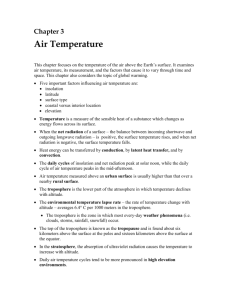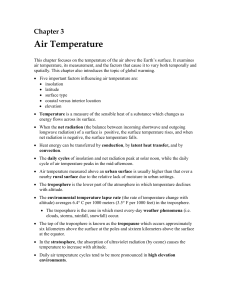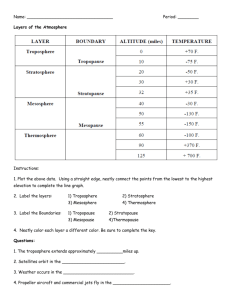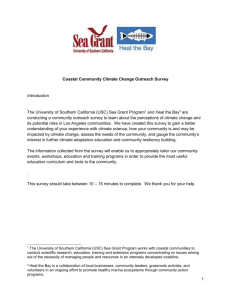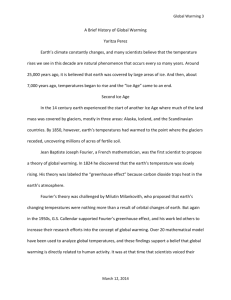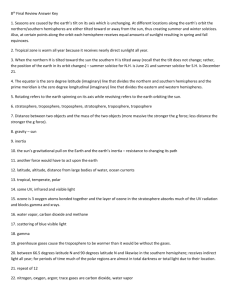On-Line Study Guide
advertisement
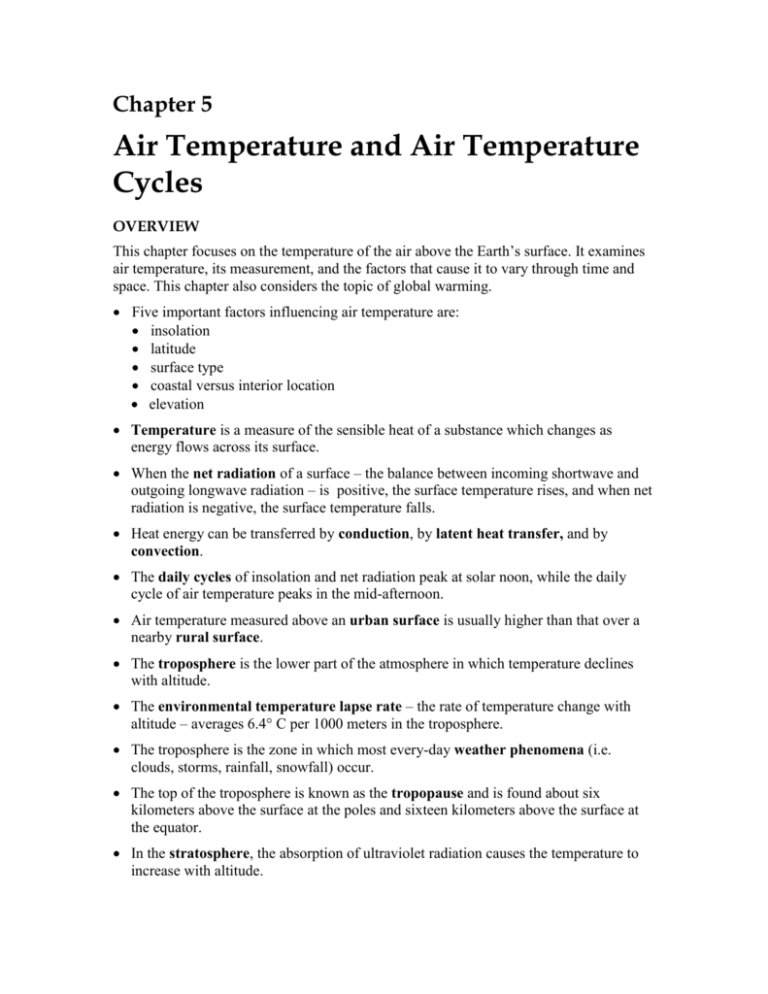
Chapter 5 Air Temperature and Air Temperature Cycles OVERVIEW This chapter focuses on the temperature of the air above the Earth’s surface. It examines air temperature, its measurement, and the factors that cause it to vary through time and space. This chapter also considers the topic of global warming. Five important factors influencing air temperature are: insolation latitude surface type coastal versus interior location elevation Temperature is a measure of the sensible heat of a substance which changes as energy flows across its surface. When the net radiation of a surface – the balance between incoming shortwave and outgoing longwave radiation – is positive, the surface temperature rises, and when net radiation is negative, the surface temperature falls. Heat energy can be transferred by conduction, by latent heat transfer, and by convection. The daily cycles of insolation and net radiation peak at solar noon, while the daily cycle of air temperature peaks in the mid-afternoon. Air temperature measured above an urban surface is usually higher than that over a nearby rural surface. The troposphere is the lower part of the atmosphere in which temperature declines with altitude. The environmental temperature lapse rate – the rate of temperature change with altitude – averages 6.4° C per 1000 meters in the troposphere. The troposphere is the zone in which most every-day weather phenomena (i.e. clouds, storms, rainfall, snowfall) occur. The top of the troposphere is known as the tropopause and is found about six kilometers above the surface at the poles and sixteen kilometers above the surface at the equator. In the stratosphere, the absorption of ultraviolet radiation causes the temperature to increase with altitude. Daily air temperature cycles tend to be more pronounced in high elevation environments. In a temperature inversion, the normal situation of air cooling with altitude is reversed and air warms with altitude. Yearly temperature range is greater in high latitude and continental locations and less at equatorial and coastal locations. The world patterns of isotherms are largely explained by latitude, coastal-interior contrasts, and elevation. Six important points about temperature patterns are: Temperatures decrease from the equator to the poles. Large landmasses in the subarctic and arctic develop centers of extremely low temperatures in winter. Temperatures in equatorial regions change little from January to July. Isotherms make a large north-south shift from January to July over continents in the midlatitude and subarctic zones. Highlands are colder than surrounding lowlands. Areas of perpetual ice and snow are intensely cold. Five important points about temperature range are: The annual temperature range increases with latitude. The greatest ranges are in the subarctic and arctic zones of Asia and North America. Annual range is moderately large on land in the tropical zone. Annual range in coastal areas is less than the range inland at the same latitude. Small temperature ranges are found near oceans in the tropical zone. Factors affecting global warming and cooling include: greenhouse gases tropospheric aerosols cloud changes land cover changes changes in solar output aerosols from volcanic activity The warming effect of the greenhouse gases (carbon dioxide, methane, nitrous oxides, ozone, and chloroflourocarbons) has exceeded the cooling effect of other factors since about 1850. Observations show both substantial annual variations in the average temperature of the lower atmosphere and a pronounced trend toward warmer temperatures in recent years. Most scientists agree that the observed atmospheric warming trend is the result of greenhouse gas emissions from human activities and that the warming trend will continue into the future. KEY TERMS air temperature conduction convection latent heat transfer net radiation celsius scale fahrenheit scale thermister inversion transpiration evapotranspiration urban heat island lapse rate environmental lapse rate troposphere stratosphere precipitation aerosols mesosphere thermosphere ozone specific heat temperature inversion isotherms temperature gradients greenhouse gases homosphere heterosphere STUDY QUESTIONS 1. What are the most important factors affecting air temperature? 2. How is heat energy transferred from place-to-place on the Earth’s surface? 3. Describe the daily temperature curve. How does it relate to the daily insolation curve? 4. What is the urban heat island? How is it formed? 5. Outline the significant features of the troposphere. 6. Why does temperature begin to increase in the stratosphere? 7. How does a high elevation influence the daily temperature and temperature range? 8. What is a temperature inversion? 9. Why does the land surface heat and cool more rapidly than the ocean surface? 10.How does a coastal location affect daily and annual temperature cycles? 11.What factors control air temperature patterns? 12.List six generalizations about the pattern of air temperature on the Earth’s surface. 13.List five generalizations about the pattern of temperature ranges on the Earth’s surface. 14.What are the factors that affect global surface temperatures? 15.How has global temperature changed over the past 150 years? 16.What impact do experts expect global warming will have? CHAPTER QUIZ Multiple Choice Questions 1. The maximum daily temperature usually occurs at approximately: a) noon b) 1 p.m. c) 3 p.m. d) 5 p.m. 2. Temperature decreases with elevation in: a) the troposphere b) the tropopause c) the stratosphere d) the thermosphere 3. The least variable temperatures on Earth would be found in: a) the equatorial zone b) the tropical zone c) the midlatitude zone d) the antarctic zone 4. The minimum average monthly temperature for a coastal location in the northern hemisphere would be experienced in: a) December b) January c) February d) March 5. The greenhouse gas contributing most to global warming at the present time is: a) carbon dioxide b) methane c) nitrous oxide d) ozone True/False Questions 1. 2. 3. 4. Urban air temperatures are generally lower than rural air temperatures. (T/F) Sensible heat transfer occurs through conduction (T/F) Temperature inversions are common in the winter over snow covered surfaces. (T/F) The lowest annual temperature ranges occur in the subarctic and arctic zones of Asia and North America. (T/F) 5. Four of the five warmest years on record since 1400 occurred during the 1990’s. (T/F) Short Answer Questions 1. What is the principle means by which heat energy is transferred between surfaces? 2. Why is the temperature range for Yakutsk, Siberia much greater than the range for Manaus, Brazil? 3. Why are we worried about climate change? 4. How does human activity affect climate? Short Essay Questions (1 - 2 paragraphs) 1. Describe how the climate of an urban area compares to the climate of a rural area. 2. Discuss the effect of a coastal location on climate. Why does this effect occur? 3. Outline the global warming issue. Internet Resources 1. The principles and techniques of temperature measurement: <http://www.unidata.ucar.edu/staff/blynds/tmp.html> 2. The Intergovernmental Panel on Climate Change (IPCC) Third Assessment Report - Climate Change 2001: <http://www.ipcc.ch/> 3. Global temperature trends: <http://www.giss.nasa.gov/research/observe/surftemp/> 4. Global temperature patterns in past centuries: <http://www.ngdc.noaa.gov/paleo/ei/ei_cover.html> 5. Weather and climate data from around the world: <http://www.intellicast.com/LocalWeather/World/>
